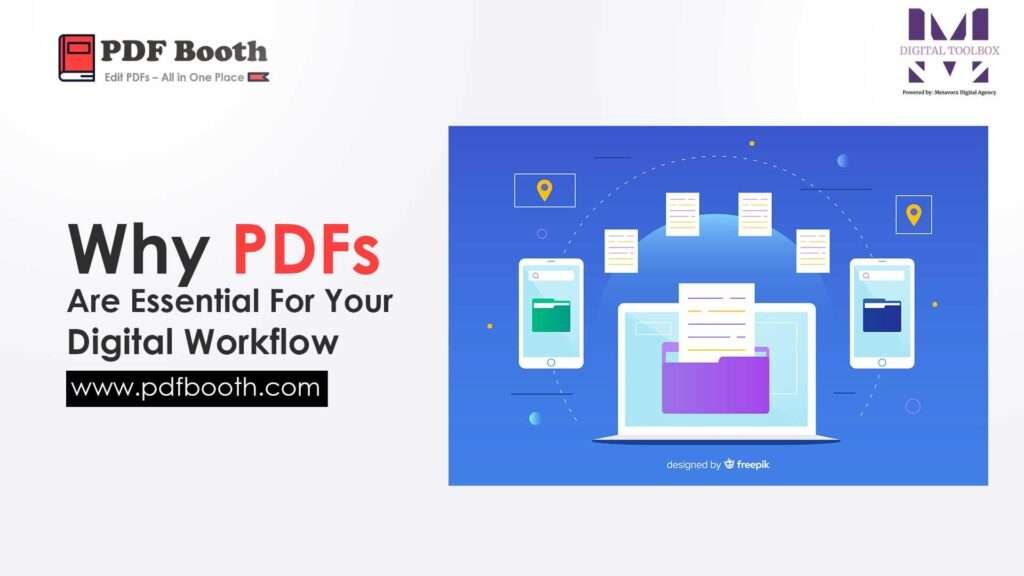Why PDFs Are Essential for Your Digital Workflow

In today’s fast-paced digital world, efficient document management is more important than ever. Whether you are working from home, collaborating with a team, or handling client documents, using the right file format can make all the difference. Portable Document Format (PDF) has become a staple in digital workflows because of its reliability, security, and versatility. In this blog, we explore why PDFs are essential for your digital workflow and how they can boost productivity, organization, and collaboration.
What is a PDF?
PDF stands for Portable Document Format, a file type developed by Adobe in the early 1990s. It allows documents to be viewed and shared across different devices and platforms without altering the formatting. This makes PDFs perfect for reports, contracts, invoices, forms, presentations, and more.
Benefits of Using PDFs in Your Digital Workflow
Consistency Across Devices
One of the biggest reasons PDFs are essential is that they maintain the same layout, fonts, and images regardless of the device or software being used. Whether you’re sending documents to a client or accessing files on a mobile device, PDFs ensure the content appears exactly as intended.
Enhanced Security
Many PDF tools offer encryption, password protection, and permissions settings. This makes PDFs ideal for sharing sensitive information while keeping it safe from unauthorized access or edits.
Easy Collaboration
PDFs can be annotated, highlighted, and commented on without altering the original content. Teams can work together, provide feedback, and finalize documents faster, improving communication and decision-making.
File Compression
Compared to other file formats, PDFs can compress large documents into smaller files without significant loss of quality. This helps in saving storage space and makes it easier to share files via email or cloud platforms.
Integration with Digital Tools
PDFs are widely supported across document management systems, project management tools, and cloud storage services. They seamlessly integrate into existing workflows, allowing for automation and faster processing.
Common Use Cases for PDFs
- Business Reports and Proposals – Share professional documents with clients or stakeholders.
- Legal Documents – Secure contracts, agreements, and compliance files.
- Education Materials – Distribute worksheets, research papers, and eBooks.
- Healthcare Records – Store medical reports and patient information securely.
- Financial Documents – Send invoices, tax returns, and expense reports.
Best Practices for Using PDFs in Your Workflow
- Use Clear File Names – Make documents easy to find by including relevant keywords.
- Compress Files Without Losing Quality – Use tools like PDF compressors to save space.
- Encrypt Sensitive Documents – Always protect confidential information.
- Organize Files into Folders – Keep your workflow neat and structured.
- Use OCR Tools – Convert scanned documents into searchable PDFs for easier access.
Conclusion
PDFs are more than just a file format — they are a cornerstone of efficient digital workflows. Their ability to preserve formatting, enhance security, and integrate with various tools makes them indispensable for businesses, educators, healthcare providers, and individuals alike. By incorporating PDFs into your daily processes, you can improve collaboration, streamline communication, and ensure your documents are both professional and secure.
Start leveraging the power of PDFs today and transform the way you work in the digital space.
FAQs:
What makes PDFs better than other document formats?
PDFs preserve formatting, support encryption, and are accessible across all devices, making them ideal for professional, educational, and legal documents.
Can PDFs be edited and shared securely?
Yes! PDFs can be annotated, password-protected, and permissions can be set to control who views or edits them.
How do PDFs help with team collaboration?
PDFs allow teams to add comments, highlight sections, and provide feedback without altering the original document, making collaboration seamless and efficient.
Are PDFs easy to compress for sharing?
Absolutely! PDF tools allow you to compress files without compromising quality, saving storage and making sharing faster.
